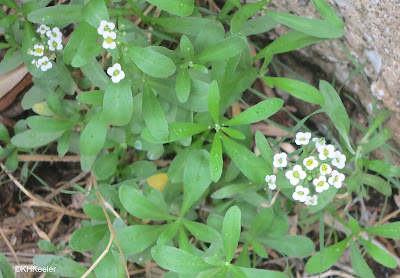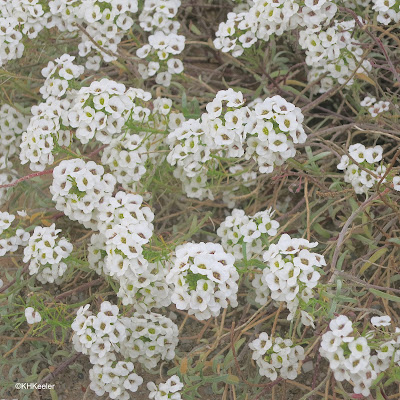Sweet alyssum is a pretty plant with white to purple flowers, frequently planted in gardens.
 |
| sweet alyssum, Lobularia maritima |
 |
| sweet alyssum, Lobularia maritima |
It is one of many small European plants in the mustard family. A big group of closely related little plants (5 in the genus Lobularia, as many as 170 in the very similar genus Alyssum, about 20 species now classified as Fibigia) were called madworts, wort meaning plant. Alyssum, as in sweet alyssum's common name, is an old Latin word meaning "not mad." Romans thought the madworts cured or prevented the madness that came from being bitten by mad dogs, that is, prevented rabies. That tradition goes back to at least Dioscorides whose 64 BCE medical treatise became a pillar of European medicinal knowledge. Dioscorides lists only one alysum, a plant now in the genus Fibigia. He wrote that alyssum was said to cure dogs of madness if fed it to them. There are a lot of treatments for rabies in Dioscorides and other early medical works; it must have been a relatively common and very scary danger.
 |
Sweet alyssum does not appear in modern or traditional herbal medicine books. I think it is more likely that it was known to herbal writers but not potent enough to include, rather than that they had never seen it. Discussions of sweet alyssum on the internet report that, in Spain, it is used as an antiscorbutic and diuretic, and in treating gonorrhea, citing a source I do not have available. That is the only specific use I have seen, except for people passing on old stories of treating rabies. Plants for a Future rates sweet alyssum as 1 out of 5 as a medicine.
 |
| sweet alyssum, Lobularia maritima |
Cunningham in his Encyclopedia of Magical Herbs does include it, saying it moderates anger if placed on the hand or body of the angry person. Another traditional use was to hang it around your neck in an amulet to counter any charms that may have been cast on you and in the house to destroy any glamours (enchantments.)
Sweet alyssum is edible, although it doesn't appear on many edible plant lists. Perhaps that is because there are a lot of tastier plants. Plants for a Future gives it a 1 out of 5 as a food. The flowers reportedly have a spicy taste--mustard family, after all--and work best as a garnish or a minor ingredient in a complex salad.
 | |
|
Of course there is a down-side. Sweet alyssum has escaped in some areas of the United States. The Invasive Plant Atlas lists it, and shows it as having escaped in scattered counties in western and northern U.S., especially in California. It does not seem to be an important weed, but it is European and acting like an invasive species, so you can find it as a plant to replace on "grow these natives instead of invasives" lists (link).
 |
| sweet alyssum, Lobularia maritima |
Easy to grow, pretty but slightly invasive, little sweet alyssum.
Comments and corrections are welcome.
References
Cunningham, S. 1993. Cunningham's Encyclopedia of Magical Herbs. Llewellyn Publishing, St. Paul, MN.Gardenia.net. Native plant alternatives to sweet alyssum. link Accessed 4/27/21
Gunther, R. T. editor. 1933. The Greek Herbal of Dioscorides. Originally 64 AD.Belknap Press, Harvard.
Invasive Plant Atlas. Sweet alyssum, Lobularia maritima (L.) Desv. link Accessed 4/27/21.
The Plant-Based Podcast. Five edible flowers you can grow at home and how to use them link Accessed 4/27/21
Kathy Keeler, A Wandering Botanist
More at awanderingbotanist.com
Join me on Facebook: https://www.facebook.com/AWanderingBotanist
No comments:
Post a Comment